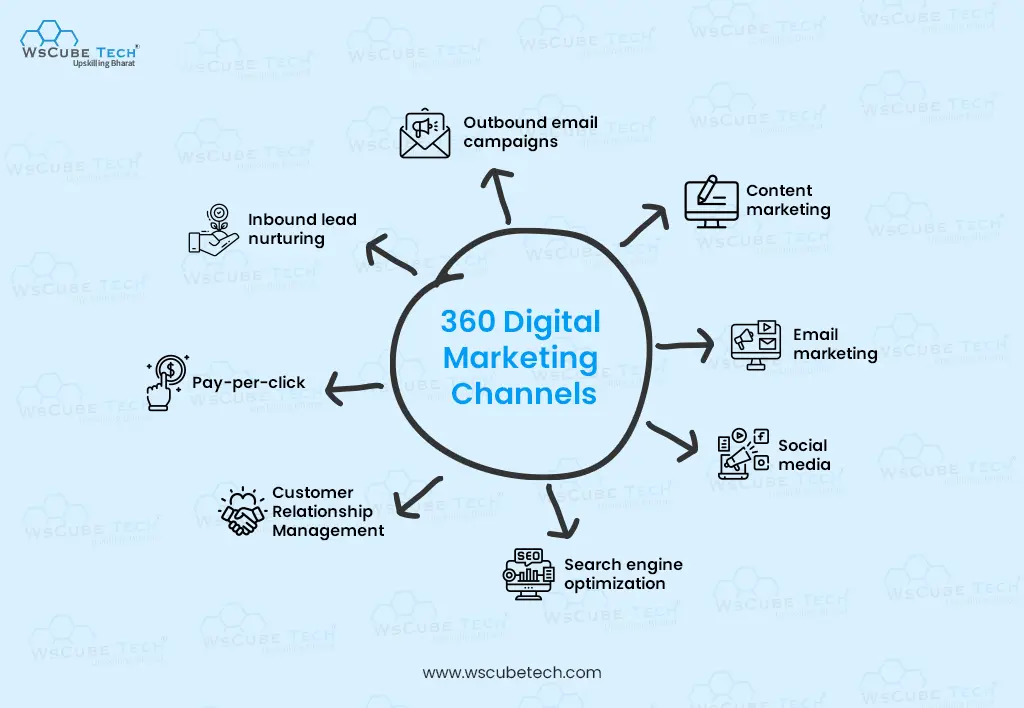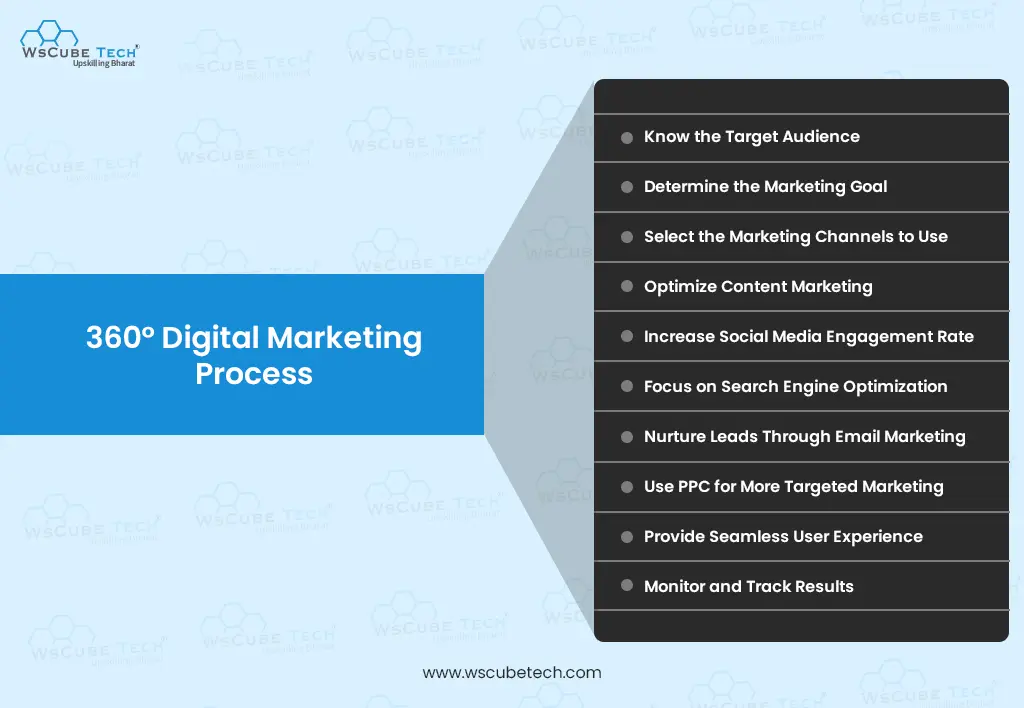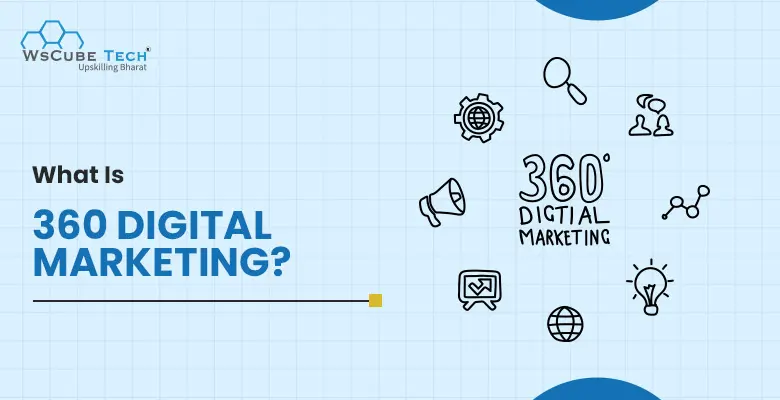The digital landscape is constantly evolving, with brands using cutting-edge marketing tactics and strategies to enhance their online visibility. Businesses need a holistic approach that leverages every marketing channel and covers every aspect of the digital realm. Hence, 360-degree digital marketing comes into play.
It is a comprehensive marketing method designed to provide a valuable user experience across all online touchpoints and gain an edge over competitors. This marketing tactic works wonders for brands and is a new buzzword in the marketing industry.
Whether you are a marketer or business owner, you must understand the fundamentals of 360 marketing and how you can use it to yield the best results. Let’s start by answering ‘what is 360-degree marketing campaign?’.
What is 360-degree Digital Marketing?
Marketers often struggle to craft a strategy that targets and reaches the maximum number of potential buyers. Despite using multiple online channels, several data-driven tactics, and unique ideas, conveying the brand message effectively is challenging.
Fortunately, 360° digital marketing is here with the perfect solution. It is a comprehensive and integrated marketing plan that takes the brand to potential customers via various advertising platforms and channels. It helps brands create a solid online presence by conveying a single message across all channels.
It combines different marketing concepts and ideas, such as style branding, visual branding, digital marketing, and more, and incorporates them into a customer journey. This ensures customers know and understand the brand and connect with it.
To know more about 360 marketing and its fundamentals, sign up for the best online digital marketing course by WsCube Tech that offers live and interactive classes led by industry leaders.

Benefits of 360-degree Marketing
Marketers and businesses are actively leveraging 360-degree marketing to generate higher returns on investments. It aims to bridge all the gaps in a marketing strategy so that businesses don’t miss any lead-generation opportunities and provide a positive customer experience.
It is a cost-efficient way to promote a brand, product, or service and communicate effectively with potential customers regardless of their age, location, or device.
One of the most significant benefits of 360 marketing is that it enables marketers to advertise their brands through multiple media. It ensures a laser-focused reach so businesses can expand their customer base and reach more people. Also, it considers and assesses a buyer’s journey through every angle. For example, we see a Zomato ad on billboards while driving, on Facebook and Instagram while scrolling, and on television while relaxing on our couch.
A 360 digital marketing covers the following channels and elements:

- Content marketing
- Email marketing
- Social media posts
- Search engine optimization
- Customer Relationship Management
- Pay-per-click
- Inbound lead nurturing
- Outbound email campaigns
Also Read: Top 10 Types of Digital Marketing in 2025 (With Details)
How to Build an Effective 360° Digital Marketing Campaign?

Now that you are familiar with 360 digital marketing meaning, let’s take a look at the key steps to build an effective 360 marketing strategy:
- Know the Target Audience
- Determine the Marketing Goal
- Select the Marketing Channels to Use
- Optimize Content Marketing
- Increase Social Media Engagement Rate
- Focus on Search Engine Optimization
- Nurture Leads Through Email Marketing
- Use PPC for More Targeted Marketing
- Provide Seamless User Experience
- Monitor and Track Results
1. Know the Target Audience
The first step in developing a 360 marketing campaign is knowing your target audience. Before you have a plan, it’s essential that you learn about your potential clients, including who they are, what they prefer, where they are, etc.
This will help you focus on a specific section of users and decide on the right platform where you will find them. Invest enough time in researching your customers, the best place to reach them, and how to convey your message to them.
You can use different social media platforms and digital marketing tools to gather data and get insights into their preferences. Find common points between buyer personas by exploring their interests, demographics, and more. You can also gather data from polls, surveys, studies, and questionnaires.
2. Determine the Marketing Goal
Now that you know who to target and offer your products or services, it’s time to set your goals for executing the 360 digital marketing campaign. This is the stage where you find the purpose of your marketing strategy. It can boost organic traffic, improve search engine rankings, build brand awareness, engage the audience, launch a new product, or increase revenue.
Your goal will help you select the right marketing channel, tools, tactics, and other factors. Based on your objectives, you can determine the budget, timeline, and resources.
Your goals should be achievable, measurable, and clear so you can build your marketing plan around them and track its performance with the expected results.
3. Select the Marketing Channels to Use
The next step to creating a 360-degree marketing plan is to find the right marketing channels to reach the target audience and establish a brand.
When it comes to online marketing channels, there are ample options available, including social media, email, blogs, websites, mobile apps, search engines, and whatnot. You don’t have to use all of them, so zero in on the ones that align with your goals and potential customers. Select digital channels that help you mark your presence in the digital world.
As you advertise your brand, product, or service on these channels, make sure that you offer a consistent brand message across all platforms. This will guide users effectively through the sales funnel and provide a unified experience.
4. Optimize Content Marketing
Content is the king. It is a crucial tool to engage the audience, interact with them, and convey the brand message. Hence, content marketing is integral to any 360-degree digital marketing campaign.
Brainstorm unique ideas to create high-quality, SEO-friendly, and relevant content that can work wonders for your brand. Craft different types of personalized content to connect better with readers and provide value. Ensure that your content answers the audience’s queries and resolves their doubts while offering useful information. It should also educate and entertain them.
From blogs and infographics to video tutorials and how-to guides, your content marketing must cover everything to engage users. It’s important to include a variety because you never know what your audience needs and responds to best.
Use a a storytelling approach to make content more compelling and encourage readers to take some sort of action. When you convey information in the form of a story, it influences readers more and connects them to the brand at an emotional level.
Your content must be optimized according to search engine algorithms so users can find it easily and rely on it to seek solutions.
Also Read: What Does a Digital Marketer Do? Work, Roles, Responsibilities
5. Increase Social Media Engagement Rate
Billions of social media users today spend hours on these channels to connect with like-minded people, discover new brands, and expand their networks.
So, you can’t ignore social media while developing a 360 marketing plan. It is the best way to reach a wider audience, engage with users, foster a community, and improve brand visibility.
As you incorporate social media into your marketing campaign, you must understand that no two platforms are alike. Twitter has its own set of audience that enjoys posting their opinion on it, while Instagram is an ideal channel for a different section of users.
So, figure out what works best for your brand and where you can find your potential customers. Based on the research and data collected in previous steps, select the best platform to post content and engage the audience.
You can use different social media tools to schedule and post content at times when your target users are most active on the selected platforms. You can also collaborate with famous people and celebrities for influencer marketing, amplifying your brand reach and credibility.
To achieve higher engagement, add visual elements such as images, videos, and infographics. Follow the latest trends and use them to your advantage.
6. Focus on Search Engine Optimization
According to research, around 93% of online experience starts with organic search. Hence, it’s important to include SEO in digital marketing strategy. SEO is the heart of any online marketing campaign as it enhances brand visibility on search engines, optimizes web pages for better user engagement, and drives traffic to the website.
Anyone who is wondering what is 360-degree marketing campaign must understand the importance of SEO to tailor their marketing tactics and redirect their efforts in the right direction.
Find relevant keywords, include them in your content, and optimize the pages to boost their search engine rankings for those keywords. This will make it easier for users to find your brand and seek solutions to their queries.
Also, if you have a brick-and-mortar store, you must work on local SEO to build brand awareness among native customers and drive traffic to your physical store.
7. Nurture Leads Through Email Marketing
Create a list of buyers and subscribers to make the most of email marketing. It is one of the most result-driven marketing methods businesses rely on to nurture leads, build trust, and establish a connection with them.
Personalize your email messages based on user preferences and behavior patterns. This will help you connect and engage with them. Also, personalized messages and subject lines compel users to open emails and go through them once.
We understand that personalizing bulk messages is challenging. Therefore, use an email marketing automation tool or software to send timely and targeted messages. This will speed up the process, freeing up time and resources that you can invest in other areas.
We also recommend conducting A/B testing to find out what’s working for your business and what isn’t, be it the subject line, CTA, or email copy.
8. Use PPC for More Targeted Marketing
You must invest in pay-per-click advertising for a more targeted marketing approach that puts your brand directly in front of users. This paid marketing technique requires you to pay a certain amount for every click on your ad. You can place your ads on social media, websites, e-commerce platforms, and other portals.
PPC is known for generating faster results but it demands a huge budget. So, mostly bigger brands and companies use PPC. Brands must use paid ads as a key component of 360 marketing but they can’t rely completely on it for results.
Businesses use PPC to increase brand awareness and drive sales. Paid ads on social media are best for gaining traction. As you place ads across different channels, make sure that the link you provide takes users to the right page where they can take the desired action.

9. Provide Seamless User Experience
Your web pages, landing pages, and websites must have responsive designs to offer a seamless and valuable user experience. Text, images, videos, and other elements must adjust accordingly to different screen sizes and devices.
Users must easily navigate the website and find products or information they seek without hassle. So, optimize user interfaces as it leads to higher conversions.
Also Read: How to Create Digital Marketing Portfolio? Full Guide
10. Monitor and Track Results
End your 360-degree marketing plan by tracking and measuring results. You must keep a close eye on the progress, monitor the results, and take corrective measures for improvements.
You can regularly check different KPIs and metrics using various tools and software. This will let you know if you are moving in the right direction and allow you to make the necessary adjustments to get back on track.
Also, evaluate data for deeper insights and find out if your research regarding the target audience was on point or not. Keep your marketing strategy flexible so you can tweak it whenever required to meet the audience’s demands and the latest trends.
Wrap Up
The best way to drive a 360-degree marketing strategy is by researching the target audience. This helps you reach all aspects of a customer’s life and take the right steps toward success. You can develop a comprehensive marketing campaign to efficiently combine all marketing channels and tactics to take your business to new heights.
Also, customers can access necessary information about your brand, which builds a strong image for your business and pays off in the long run. This holistic approach is a proven way to mark your presence at every touchpoint where potential consumers can enter the sales funnel. You can create long-term and meaningful relationships with them, drive engagement, and establish a brand that stands out.
If reading and following so many steps seem overwhelming, then join our digital marketing course to hone your skills and gain practical experience under the guidance of experienced mentors.
FAQs About 360 Digital Marketing
360 digital marketing is a comprehensive marketing approach that combines different online marketing channels and techniques, including SEO, social media, email marketing, PPC, content marketing, and analytics, providing a complete marketing solution.
Traditional marketing uses offline methods and resources, such as print ads, billboards, and TV commercials, while 360 digital marketing focuses on online platforms to reach a broader and more specific audience.
360 digital marketing enables businesses to improve customer engagement, build a strong online presence, increase brand awareness, and reach the target audience through multiple digital platforms.
360 digital marketing includes Pay-Per-Click Advertising (PPC), Affiliate Marketing, Search Engine Optimization (SEO), Analytics & Performance Tracking, Email Marketing, Social Media Marketing (SMM), Conversion Rate Optimization (CRO), Content Marketing, and Influencer Marketing.
SEO is a popular marketing technique that helps businesses improve a website’s visibility on search engines like Google, so potential customers can organically find a business.
Businesses use social media marketing to connect with the target audience, offer personalized services, build brand awareness, and generate leads through leading platforms like Facebook, Instagram, LinkedIn, Twitter, and TikTok.
Although PPC is not mandatory, paid ad marketing tactics like Google Ads and Facebook Ads, help businesses get instant visibility and drive targeted traffic to their websites.
The 360 digital marketing technique enables small businesses to compete with larger brands by providing cost-effective digital strategies like SEO, social media, and local SEO.
It varies on the marketing strategy. For example, PPC can deliver instant results, while SEO takes months. On the other hand, social media engagement builds over time.
Read more blogs:



